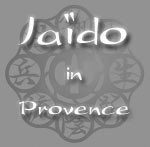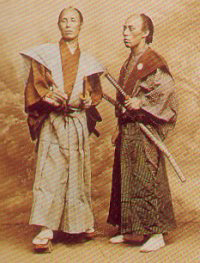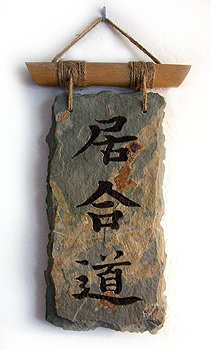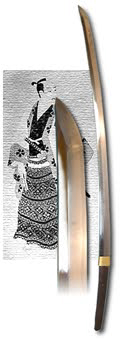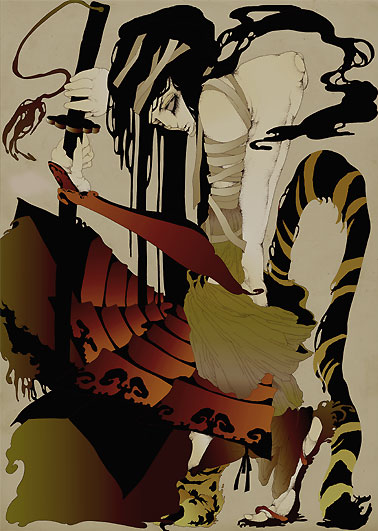|
|
|
|
Original web site : http://www.kusastro.kyoto-u.ac.jp/~baba/iaido
What is Iaïdo ?
Iaido is one of the Japanese traditional Budo concerned with drawing the blade and cutting in the same motion. (Budo means martial arts or military arts in Japan). A typical form consists of the draw and cut, a finishing cut, cleaning the blade and returning it to the scabbard, all without looking away from the imaginary opponent. Most practice is solo, eventually with shin-ken (a real blade). In contrast with Kendo, Iaido is performed without protective coverings of any kind. Students must strive to achieve power, precision and perfection in their form. Along the way they learn balance, grace, and control both of the body and the mind. Iaido dealt more with everyday situation rather than those on the battlefield. The term "Iai" is taken from the Japanese phrase: "Tsune ni ite, kyu ni awasu". The meaning of this is, whatever we may be doing or wherever we may be, we must always be prepared from any eventually. The techniques themselves dealt with many situations such as a sudden attack by several opponents, a surprise attack while bowing to someone, an enemy lying in wait behind a sliding door or an attack in a darkened room. The permutations (suppositions) were countless.
Concept
Saya-no-uchi -- the essence of Iaido
"Saya no uchi" is a truncated phrase. A full-length phrase is "Saya no uchi de katsu", those of which meaning is: Victory in the scabbard of the sword. The real intention is: One must obtain victory while the sword is un-drawn. This seems to be inconsistent for the reason which a disciplinant wields his blade, but it is agreeable as the ultimate aim of the real swordmanship. The essence of Iaido is a non-combative discipline engaged in for the individual's spiritual cultivation. Through the blade we seek to improve our spirit and become better people, to promote peace and good feeling beyond the walls of the Do-Jo and into out daily lives.
Readiness on the occasion of practice
One must bear in mind the higher goals to achieve and take each steps and overcome each obstacle, but at the same time, one must relish and enjoy his challenges, though the path may be a difficult one to follow. If one studies the classical Budo for fun or through a whim, no true understanding is possible. The goal of self-perfection requires time and effort, and direction is always more important than haste. The classical Budo disclose their meaning only to those who are dedicated and who exert their minds and bodies in rigorous training. There are many styles of Iaido, many ways to cut, to move, and as one learns one improves technically. However, we train not only to learn techniques, but also to cultivate the heart and spirit. With this respect all "styles" will lead to the same goal.
History and SchoolFounder
Iaido began in the mid-1500's. Hayashizaki Jinsuke Shigenobu (1542 - 1621) is widely accepted as the founder of Iaido. There were many (probably several thousand of) Koryu ( traditional schools), though only a small proportion remain today. Almost all of them also study older school established during 16-17th century, like Muso-Shinden-ryu, Hoki-ryu, Muso-Jikiden-Eishin-ryu, Shinto-Munen-ryu, Tamiya-ryu, Yagyu-Shinkage-ryu, Mugai-ryu, Sekiguchi-ryu, and so on. The role of Iaido in modern Kendo
Even though the points of attack in modern Kendo are strictly limited, the strikes and attacks are performed with a freedom of will that inevitably leads to an element of competition. If this spirit of competition is given fuller reign, Kendo degenerates into a contest carried out solely for the sake of winning and loosing. When this happens, the purity of Kendo techniques is lost. In comparison with shinai Kendo, Iaido concentrate on training to develop correct movements. For this reason, in terms of technical purity it occupies a level much higher than that of shinai Kendo. In short, Iaido can serve to improve and maintain technical purity in shinai Kendo. Iaido helps ensure that body movements are logical and effective because they are natural, accurate, and agile.
Basic PointsZanshin
This is a word which does not translate at all into English. It is often translated as awareness, but this is not quite right. Awareness of what is around, potential threats, potential dangers etc. is a part of it. It is more concerned with the state of mind after an action has been made. It is characterized by kamae or shisei after cutting, by seme after cutting, by projection of ki and continuation of breathing (or kiai where appropriate) after cutting.
Ma (Maai)
Attack intervals. One must keep the proper attack intervals.
Metsuke
Gazing at the distant mountains. This means to focus the eyes at a distance.
Te-no-uchi
Grip the handle of the blade. One must grip rightly for the effective nukitsuke and kirioroshi. Iaido master can easily distinguish an sword-craft of trainee only at a glance over his Te-no-uchi. |
Technical Points
No matter what style was practiced, the procedure always comprised four separate parts: the drawing of the blade to meet a sudden encounter (nukituke), the cut or cuts used to despatch the enemy (kirioroshi), the shaking of the blood from the blade (chiburi), and the re-sheathing of the sword (noto).
Nukitsuke (Nukiuchi)
The first strike, though single handed, should be effective. It should make kirioroshi unnecessary. The angle, timing, control will all be watched. Keep good posture here. Make sure the cut lands with the front foot and that the body weight is giving power to cut.
Kirioroshi (Kiritsuke)
Strike to the imaginary enemy. There are some aphorism about Kiriososhi: If trainee disturbs himself, it would be a wicked swordplay. If trainee doesn't have a fighting spirit, it would be only a sword dance. If trainee doesn't strain, it would be only a fun.
Chiburi (Chiburui)
Shaking the enemy's blood. One must bear in mind Zanshin during the chiburi and noto.
Noto
The discipline of swordmanship in Iaido fashion provides an easily understood example of the intense concentration demanded by Budo techniques. The trainee must, in the final stage of wielding the sword, return its razor-sharp blade to the scabbard he wears at his left hip. The action used in accomplishing this brings the operator's left hand within a fraction of an inch of the keen edge, in itself an unnerving maneuver for the untrained, but one made infinitely more delicate by the fact that the action must be performed without once looking at the scabbard.
Zen Nihon Kendo Renmei Seitei Iaido
All students perhaps study a standard Iaido, commonly known as the Seitei Iai, which is established by the All Japan Kendo Federation (Zen Nihon Kendo Renmei, hereafter ZNKR). There are 10 established forms of ZNKR Seitei Iaido (hereafter Seitei Iai) which were developed during 1960's and 70's by a panel appointed by ZNKR for that purpose. The original intentions in creating Seitei Iai was to produce a standard that could used for gradings nationally and later internationally. These ten forms belong to three sections. The first to third forms belong to Seiza no bu, which performed from seiza posture. The fourth form belongs to Tatehiza no bu, which performed from tatehiza (low-crouching posture). And the fifth to tenth forms belong to Tachi no bu, which performed from a standing posture.
In the fall of 2000, ZNKR newly added two forms named "Sou giri" and "Nuki uchi". So now Seitei Iai consists of twelve forms.
|
